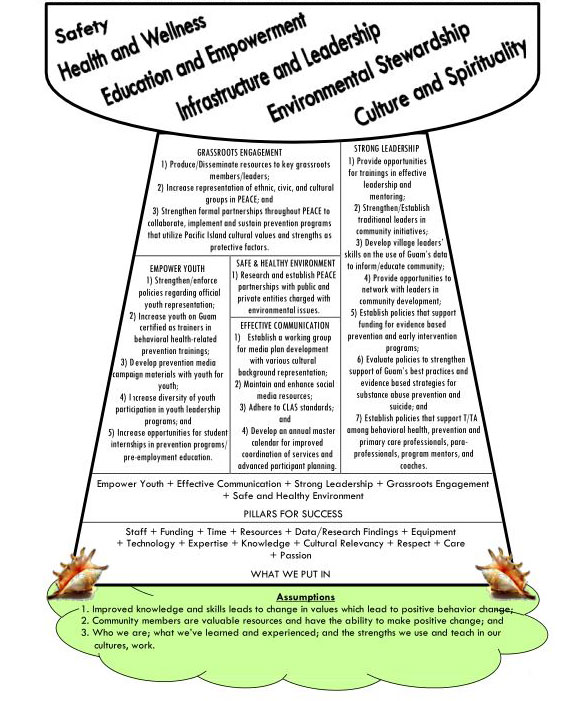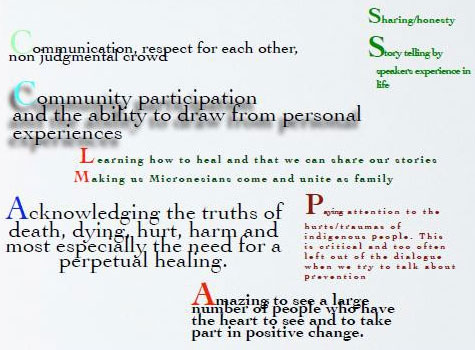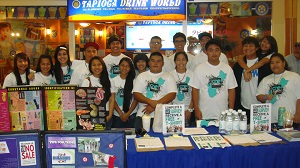THE LATTE FOUNDATION FOR SUCCESSFUL COMMUNITY PREVENTION EFFORTS
The new look of Guam’s Logic Model for PEACE reflects the Latte Stone, a symbol of the indigenous Chamorro culture that reflects a rich cultural heritage in the Pacific whose strength and pride centers on the foundation of accepted responsibility for taking caring of one another. The Chamorro culture, like most other Pacific Island cultures builds upon the concept of “we-esteem” and not “self-esteem”, whereby individuals, families and the broader community works and lives interdependently and not independently. All belong to this One Nation of Pacific peoples who give generously in support of one another as part of daily living and by providing resources and help especially during times of need and crisis.
THE LATTE FOUNDATION FOR SUCCESSFUL COMMUNITY PREVENTION EFFORTS

PILLARS FOR PEACE PLAN IMPLEMENTATION
 During Guam’s August 2013 Gathering of Pacific Islanders for PEACE, two hundred youth and adults actively participated in facilitated discussions about what the meaning of PEACE (Prevention Education and Community Empowerment) is to them, what their vision for Guam in 2018 was, and what they felt were important and necessary strategies and actions that must be included in Guam’s 5-Year Comprehensive PEACE Plan in order to achieve their shared Vision for Guam in 2018. Key planning areas upon which GOPEACE stakeholders focused on for enhancing Guam’s prevention and early intervention services include attention to: Culture, Safety, Health, Infrastructure, Education and the Environment. The majority felt strongly that PEACE efforts needed to help build a foundation of awareness and acceptance of the diverse groups of Pacific Islanders who live among the indigenous Chamorro people of Guam. Their common principles and cultural values of respect and spirituality as peoples of the Pacific are the strengths upon which important relationships and partnerships will be built for PEACE. GOPEACE participants also felt strongly that a safer, clean and healthier ecosystem was critical to fostering and sustaining positive behavioral health among the people of Guam. A holistic approach for improving Guam’s infrastructure, human services system and public safety is needed and thereby requires true collaboration and active participation from spiritual and cultural leaders, elected government officials, primary and behavioral health care providers, agriculture and aquaculture resources, educational institutions, law enforcement, private businesses, youth, parents and families. Specific 5-Year PEACE Plan strategies and action steps were proposed as follows:
During Guam’s August 2013 Gathering of Pacific Islanders for PEACE, two hundred youth and adults actively participated in facilitated discussions about what the meaning of PEACE (Prevention Education and Community Empowerment) is to them, what their vision for Guam in 2018 was, and what they felt were important and necessary strategies and actions that must be included in Guam’s 5-Year Comprehensive PEACE Plan in order to achieve their shared Vision for Guam in 2018. Key planning areas upon which GOPEACE stakeholders focused on for enhancing Guam’s prevention and early intervention services include attention to: Culture, Safety, Health, Infrastructure, Education and the Environment. The majority felt strongly that PEACE efforts needed to help build a foundation of awareness and acceptance of the diverse groups of Pacific Islanders who live among the indigenous Chamorro people of Guam. Their common principles and cultural values of respect and spirituality as peoples of the Pacific are the strengths upon which important relationships and partnerships will be built for PEACE. GOPEACE participants also felt strongly that a safer, clean and healthier ecosystem was critical to fostering and sustaining positive behavioral health among the people of Guam. A holistic approach for improving Guam’s infrastructure, human services system and public safety is needed and thereby requires true collaboration and active participation from spiritual and cultural leaders, elected government officials, primary and behavioral health care providers, agriculture and aquaculture resources, educational institutions, law enforcement, private businesses, youth, parents and families. Specific 5-Year PEACE Plan strategies and action steps were proposed as follows:
1. Empowered Youth: Engage and empower our youth - providing a safe and healthy future for our youth.
|
The youth identified education excellence as a foundation step towards success in their lives. With formal education, opportunities would be more realistically available to help them achieve personal, family and community goals; to be part of the change that includes perpetuating the cultural values, beliefs, strengths and practices among the Pacific Island cultures. |
||
|
Strategies |
Action Steps |
Projected Timelines |
|
Strengthen and enforce local policies regarding official youth representation on official Government of Guam Boards, Councils and Committees, as well as government-funded organizations that serve youths’ interests. |
Promote inclusion of youth and diversity in their representation from ethnic groups, military, and LGBT; including the promotion of active participation of youth from high risk backgrounds, those that have been involved in the Juvenile Justice System and youth in recovery. Generate recommendations and nominations of individuals for official submission.
|
Year One – 1st and 2nd Quarters |
|
Increase number of youth on Guam certified as trainers in behavioral health-related prevention trainings. |
Identify youth who meet the age criteria to become certified trainers in prevention courses such as Substance Abuse Develop formal Agreements between GBHWC and youth or youth organization indicating commitment to receive training certification and to conduct training for their peers as needed. |
Year One – 3rd and 4th Quarters |
|
Develop prevention media campaign materials (print and electronic) with youth, for youth. |
Identify youth mentors and role models in prevention who are potentially influential with their peers and who represent cultural and ethnic diversity. Conduct focus groups and other activities involving youth who will help develop media concepts, designs, product development and distribution plan. |
Year One - 3rd and 4th Quarters |
|
Increase diversity of youth representation and participation in youth leadership programs and events. |
Develop and strengthen partnerships by including organizations who serve youth such as Youth for Youth Live Guam, Just Say No Dance Crew, Sanctuary, Inc., Guam Alternative Lifestyle Association (GALA), public and private schools, faith- based organizations. Recruit youth who are underserved and who may be at greater risk for self-harm and substance use/abuse (including youth in recovery and those involved in the Juvenile Justice System) to participate in island wide prevention programs and services that offer knowledge, training, resources and support. |
Year One –2nd Quarter and ongoing |
|
Increase opportunities for student internships in prevention programs as well as pre-employment education and training in the behavioral health field and other career fields of interest. |
Promote “stay-in-school” messages to encourage students to complete high school graduation requirements. Encourage applicants for Prevention Fellowship Programs such as what is offered by SAMHSA/CSAP. Promote student registration for established behavioral health courses at the Guam Community College. |
Year One – 3rd and 4th Quarters |
2. Effective Communication: Implement a social media and communications plan that is inclusive and culturally responsive.
|
Community stakeholders find media campaign messages more relatable and effective when a personal story is told and by a person who is familiar and respected from their community, and in their primary language and form of communication. |
||
|
Strategies |
Action Steps |
Projected Timelines |
|
Establish a working group for media campaign plan development with 12-15 individuals who represent youth and adults from various cultural backgrounds and professions. |
Invite members from known cultural groups and organizations to include GOPEACE participants. Orient group members to PEACE work and resources that have been developed such as the Epidemiological Profiles on Substance Abuse and Suicide and Info graphics. Develop framework and prevention focus for media campaign theme, audio and visual products, targeted populations and communities and dissemination. Develop a process for soliciting and receiving community feedback. |
Year One- 1st and 2nd Quarters |
|
Maintain and enhance social media and marketing resources for PEACE. |
Assess current utilization rates of www.peaceguam.org website. Increase the number of informative website links to other community resources such as the NCD consortium and committees that promote overall health and wellness. |
Year One- 2nd Quarter and ongoing |
|
Adhere to CLAS (cultural and linguistically appropriate services) standards in all media campaign materials development. |
Assess special needs of individuals who may be involved in PEACE events who are visually, hearing or physically impaired and require special accommodations or training resources (such as ASIST workbooks in Braille). Obtain needed resources and technical support for the conduct of trainings and/or the effective delivery of prevention services. |
Year One – 1st and 2nd Quarters |
|
Develop an annual master calendar for training and other prevention-related events for improved coordination of T/TA services and advanced participant planning. |
Solicit information from public and private organizations on planned trainings that may be of interest to PEACE. Include relevant trainings on a PEACE Master Training Calendar and make available on www.peaceguam.org or distribute via e-mail and post hardcopies in key community spots. |
Year One - 1st and 2nd Quarters |
3. Strong Leadership: Demonstrating strong leadership through integrity, transparency, and follow-through.
|
The 2013 GOPEACE was attended by a significant number of natural born leaders who represent people from their ethnic and cultural groups, civic/social and faith-based organizations, school and village communities, youth and parent organizations, and persons in recovery who now mentor and inspire others. Leaders among Pacific Islander groups are respected, trusted and counted on to voice concerns of those who may be underserved, underrepresented and/or misrepresented. |
||
|
Strategies |
Action Steps |
Projected Timelines |
|
Provide opportunities for trainings in effective leadership and mentoring in behavioral health. |
Identify and recruit natural leaders from within the Chamorro, Chuukese, Filipino, and other Pacific Islander and Asian communities, and consumers in recovery and/or being served by established health and human services such as GBHWC, DISID and Guam Legal Services. Identify and conduct evidenced-based leadership training programs that is culturally based and that will enhance CLAS adherence and competence. |
Year One - 2nd and 3rd Quarters |
|
Strengthen and/or establish policies and programs that acknowledge, support and utilize traditional and grassroots leaders in community development initiatives that address social issues. |
Identify community leaders and champions who can be prepared to lead in community-driven initiatives. Review identified community needs, challenges and obstacles that have been raised during 2013 GOPEACE event. Prioritize community needs and align with existing resources. Assess public policies and programs that exist for the purpose of meeting a specific community need. Develop specific strategies that address identified challenges and obstacles and list recommendations for improving services Provide advocacy trainings for raising awareness about social issues and effectively educating policy makers from the grassroots’ perspective and experience. Include in government Boards, Councils and Commissions official stakeholder representation from ethnic groups. |
Year Two - 1st and 2nd Quarters |
|
Develop confidence and competence among leaders in each village on the use of Guam’s data to inform and educate people in the grassroots community. |
Identify key village representatives who are interested in learning about Guam’s Epidemiological Profiles and the use of substance use and suicide data to inform and guide in decision-making processes. Conduct semi-annual meetings with village representatives to discuss data- driven, community-driven strategies for prevention and early intervention. Develop strategies for distributing PEACE Info graphics to keep the general public aware of local data and the current state of affairs. Include in annual Gathering of Pacific Islanders for PEACE conferences sessions on Guam’s Epidemiological Profile Updates |
Year One – 4th Quarter and Year Two – 1st Quarter |
|
Provide opportunities to network and learn from and access local, regional and national organizations and leaders in community development. |
Establish and maintain CADCA (Community Anti-Drug Coalitions of America) Membership and attendance in annual conferences. Establish and maintain APPEAL (Asian Pacific Partnerships for Empowerment, Advocacy and Leadership). Maintain working relationship with the Native Aspirations Project for the continued use of the GONA Curriculum and for further training and technical assistance as needed. Attend national conferences and meetings, and participate in relevant webinars. Conduct Annual Gathering of Pacific Islanders (GOPI). |
Year One - 2nd Quarter and ongoing |
|
Establish public policy that supports and appropriates funding for the implementation of evidenced-based prevention and early intervention programs for substance abuse and suicide (e.g. GONA, ASIST, safeTALK, Connect, Suicide Prevention Toolkit, Responsible Beverage Servers Training). |
Identify laws that direct funding and resources to support prevention Expand and strengthen Guam policies that sustain leveraging of resources and integration of prevention efforts across agencies. Draft proposed policies that direct prevention funding to organizations who are oriented to the SPF 5-step process. |
Year One – 4th Quarter and ongoing |
|
Evaluate and change public policies to strengthen support of Guam’s best practices and evidence-based strategies for prevention and early intervention programs and services for substance abuse and suicide. |
Identify laws that that support evidence- based strategies for prevention and early intervention programs, policies and practices. Expand and strengthen laws that sustain positive outcomes as it relates to local research and funding. |
Year One – 4th Quarter and ongoing |
|
Establish public and organizational policies that support on-going training and technical assistance among behavioral health, prevention and primary care professionals, para- professionals, program mentors and coaches. |
Assess and utilize local expertise in behavioral health and primary care practices on Guam. Identify and prioritize inter-disciplinary and multi-sectoral trainings and opportunities for peer mentoring. Establish training programs for certification of prevention specialists and Employee Assistance Program managers in an identified evidence-based workplace program that will be institutionalized. Establish written formal agreements between the Government of Guam and entities trained as trainers to conduct and provide T/TA |
Year One - 2nd and 3rd Quarters |
4. Grassroots Engagement: Foster community involvement through meaningful outreach, inclusion and engagement with all communities.
|
There has been significant presence and publicity of PEACE information and resources distributed in the media. GOPEACE community members stand ready to assist with the dissemination of media campaign products, program notices and educational materials to ensure that members of their cultural group, village community and diverse networks are informed. A more strategic and direct approach will be taken to effectively deliver these resources into the hands of the grassroots community leaders and members and to increase attendance at PEACE events. |
||
|
Strategies |
Action Steps |
Projected Timelines |
|
Produce and disseminate electronic and print resources to key grassroots community members and leaders. |
Recruit key GOPEACE participants to serve as points of contact to receive and distribute PEACE resources in their villages and cultural networks. |
Year One - 1st and 2nd Quarters Ongoing |
|
Increase representation and diversity of ethnic, civic and cultural groups in PEACE trainings and meetings. |
Provide incentives and meaningful educational rewards for community members’ attendance. Develop training materials and evaluation processes that would enhance participation, skills development and sustained partnerships. Increase access to public transportation. |
Ongoing |
|
Strengthen formal partnerships and written Agreements throughout the PEACE network to collaborate, implement and sustain prevention programs, policies and practices that are true protective factors among Pacific Island cultural values and strengths used in prevention. |
Explore partnerships with agencies, organizations and network that share PEACE’s vision and are capable of engaging Chamorro and other Micronesian youth and young adults, LGBTQ and the military. Establish written Agreements or membership with identified community- based groups and organizations, public and private agencies Execute written agreements for joint projects and activities. |
Year One - 2nd Quarter and ongoing |
5. A Safe and Healthy Environment: Securing a sustainable, healthy environment for Guam
|
GOPEACE participants feel strongly that in order to have good mental, physical and spiritual health, the island ecosystem (land, water, air) in which the people of Guam live and must thrive on, must be healthy as well. There is a direct relationship between the environment and an individual’s and community’s health. The island’s natural resources must be protected and safe and to accomplish this, each resident must accept individual responsibility and stewardship for maintaining and sustaining positive environmental actions that impact on behavioral health. |
||
|
Strategies |
Action Steps |
Projected Timelines |
|
Research and establish PEACE partnerships with public and private entities charged with environmental issues (e.g. Guam Environmental Protection Agency, Department of Agriculture, University of Guam, the Department of Public Health and Social Services, Department of Parks & Recreation, Department of Land Management, Fish and Wildlife, and others). |
Identify common strategies for promoting environmentally conscious campaign messages that raise awareness for personal, environmental and behavioral health. Provide training opportunities for PEACE constituent learning about environmental strategies that can be incorporated into procurement of environment friendly PEACE program resources (i.e. reducing, reusing and recycling waste). Develop joint media campaign strategies and products that influence community stewardship for a healthier island community and promotes environmental stewardship that encourages individuals to think more critically of how our behaviors are affecting our environment. |
Year One - 4th Quarter and ongoing |






